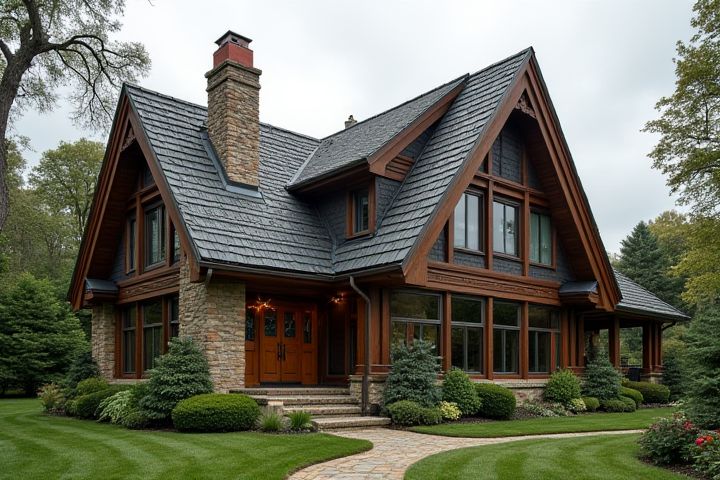
When selecting the best house roof, consider asphalt shingles for their affordability and ease of installation, making them popular for many homeowners. Metal roofing offers durability and energy efficiency, reflecting sunlight and reducing cooling costs. Tile roofs, known for their longevity and aesthetic appeal, require a sturdy structure due to their weight but can enhance your home's curb appeal significantly. For environmentally conscious homeowners, green roofs, which incorporate vegetation, provide insulation and promote biodiversity. Evaluate your local climate, budget, and desired lifespan when choosing the ideal roofing material for your home.
What House Roof Is Best
Durability
Metal roofs, particularly standing seam variants, offer exceptional durability with a lifespan exceeding 50 years when properly installed and maintained. These roofs can withstand extreme weather conditions, including high winds up to 140 mph and significant snowfall, reducing the risk of damage. They are also resistant to rust, corrosion, and pest infestations thanks to their protective coatings. Choosing a metal roof not only enhances your home's durability but also contributes to energy efficiency, reflecting solar heat and potentially lowering cooling costs by 10-25%.
Energy Efficiency
The most energy-efficient roofing option is a cool roof, which reflects more sunlight and absorbs less heat, helping to lower your energy bills. Options like metal roofing, which can have a reflective coating, show a potential reduction in cooling costs by 10-15%. Another excellent choice is tile roofing, particularly in materials such as clay or concrete, known for their durability and thermal performance. You should also consider green roofs, which provide insulation and absorb rainwater, further enhancing your home's overall energy efficiency.
Cost
When considering cost-effective roofing options, asphalt shingles are often the most economical choice, averaging between $90 to $100 per square. This material is readily available and can last between 20 to 30 years with proper maintenance, making it a budget-friendly investment. Metal roofing, though initially more expensive at approximately $120 to $900 per square, offers longevity of 40 to 70 years and can result in savings on energy costs over time. For a more durable yet still affordable alternative, consider architectural asphalt shingles, which provide enhanced aesthetics and performance for a slightly higher price, typically around $100 to $120 per square.
Climate Suitability
The best roofing materials for climate suitability depend on your specific weather conditions. For hot climates, reflective metal roofs or light-colored shingles can reduce heat absorption and lower energy costs. In areas with heavy snowfall, asphalt shingles or metal roofs with a steep slope help prevent snow accumulation and ice damming. For regions prone to hurricanes, impact-resistant tiles or concrete roofs offer enhanced durability against high winds and flying debris.
Aesthetic Appeal
The best house roofs for aesthetic appeal include gable, hip, and mansard styles, each providing distinct architectural charm. Gable roofs, characterized by their triangular shape, create a classic look, often complemented by decorative shingles or vibrant colors. Hip roofs, sloping on all sides, offer a more contemporary feel and better wind resistance, making them visually appealing in varied landscapes. Meanwhile, mansard roofs, with their dual slopes, can enhance your home's silhouette and provide additional living space, making them both stylish and functional.
Maintenance Requirements
Asphalt shingles are one of the best roofing options when it comes to maintenance requirements, offering a balance of affordability and longevity. They typically require minimal upkeep, with periodic inspections recommended every few years to check for damage or wear. Metal roofs, while initially more expensive, are highly durable and can last up to 50 years, requiring little more than an occasional cleaning to prevent rust. If you prioritize low maintenance, consider materials like slate or tiles, which have excellent longevity but may require specialized service for repairs or replacements due to their weight and fragility.
Weight and Structural Support
When considering weight and structural support for a house roof, a gabled roof is often the best option due to its efficient load distribution and balance. This design, featuring two sloped sides that meet at a peak, allows rain and snow to easily slide off, reducing the risk of structural stress. You may also explore truss systems, which provide excellent support while minimizing the amount of raw material needed, resulting in a lighter overall roof system. Additionally, using lightweight materials like metal or engineered wood can further enhance structural integrity without compromising safety.
Fire Resistance
Metal roofing is widely recognized for its exceptional fire resistance, making it an ideal choice for homeowners concerned about fire safety. Unlike traditional shingles, metal roofs are non-combustible and can withstand intense heat and flames, significantly reducing the risk of ignition during wildfires. Clay or concrete tiles also offer high fire resistance, providing durable protection while enhancing the aesthetic appeal of your home. When selecting roofing materials, consider options rated Class A for fire resistance to ensure the highest level of safety.
Environmental Impact
When considering the environmental impact of house roofs, cool roofs made from reflective materials are among the best options. These roofs reflect more sunlight and absorb less heat, which helps in reducing energy consumption for cooling, ultimately lowering greenhouse gas emissions. Green roofs, covered with vegetation, also provide excellent insulation, manage stormwater runoff, and enhance biodiversity, making them a sustainable choice. For homeowners focused on energy efficiency, solar panel installations on roofs can harness renewable energy, further reducing reliance on fossil fuels.
Warranty and Lifespan
Asphalt shingles typically offer a warranty ranging from 20 to 30 years, while architectural shingles can extend that lifespan up to 50 years with proper maintenance. Metal roofs, known for their durability, often come with warranties of 40 years or more and can last 50 to 70 years, making them a long-term investment. Slate and tile roofs provide exceptional longevity, often exceeding 100 years, but their warranties may range from 50 to 75 years due to their high-cost installation. If you seek a balanced option, consider architectural shingles for a blend of affordability and extended lifespan, ensuring peace of mind for decades.
